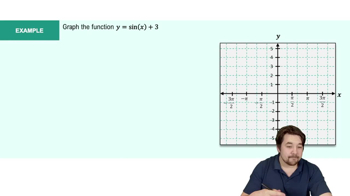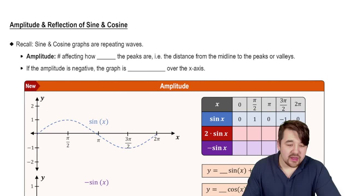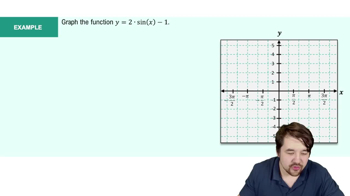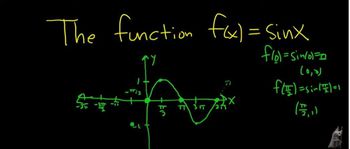Table of contents
- 0. Review of College Algebra4h 43m
- 1. Measuring Angles39m
- 2. Trigonometric Functions on Right Triangles2h 5m
- 3. Unit Circle1h 19m
- 4. Graphing Trigonometric Functions1h 19m
- 5. Inverse Trigonometric Functions and Basic Trigonometric Equations1h 41m
- 6. Trigonometric Identities and More Equations2h 34m
- 7. Non-Right Triangles1h 38m
- 8. Vectors2h 25m
- 9. Polar Equations2h 5m
- 10. Parametric Equations1h 6m
- 11. Graphing Complex Numbers1h 7m
4. Graphing Trigonometric Functions
Graphs of the Sine and Cosine Functions
Problem 4.7b
Textbook Question
Fill in the blank(s) to correctly complete each sentence.
The graph of y = 3 + 5 cos (x + π/5) is obtained by shifting the graph of y = cos x horizontally ________ unit(s) to the __________, (right/left) stretching it vertically by a factor of ________, and then shifting it vertically ________ unit(s) __________. (up/down)
 Verified step by step guidance
Verified step by step guidance1
Identify the horizontal shift by examining the phase shift in the equation \(y = 3 + 5 \cos(x + \pi/5)\). The term \(x + \pi/5\) indicates a shift to the left by \(\pi/5\) units.
Determine the vertical stretch by looking at the coefficient of the cosine function. The coefficient 5 indicates a vertical stretch by a factor of 5.
Identify the vertical shift by examining the constant term in the equation. The constant 3 indicates a vertical shift upwards by 3 units.
Summarize the transformations: The graph of \(y = \cos x\) is shifted \(\pi/5\) units to the left, stretched vertically by a factor of 5, and shifted 3 units upwards.
Ensure understanding by visualizing or sketching the transformations step by step, starting with the horizontal shift, followed by the vertical stretch, and finally the vertical shift.
Recommended similar problem, with video answer:
 Verified Solution
Verified SolutionThis video solution was recommended by our tutors as helpful for the problem above
Video duration:
0m:0sPlay a video:
Was this helpful?
Key Concepts
Here are the essential concepts you must grasp in order to answer the question correctly.
Horizontal Shifts
Horizontal shifts in trigonometric functions occur when the input variable (x) is modified by adding or subtracting a constant. In the equation y = 3 + 5 cos(x + π/5), the term (x + π/5) indicates a leftward shift of π/5 units. This is because adding a positive value inside the function moves the graph to the left.
Recommended video:
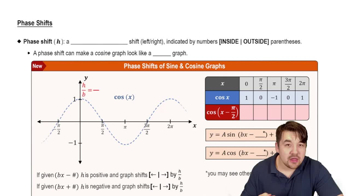
Phase Shifts
Vertical Stretching
Vertical stretching refers to the scaling of the function's output values. In the equation y = 3 + 5 cos(x + π/5), the coefficient 5 in front of the cosine function indicates that the graph is stretched vertically by a factor of 5. This means that the amplitude of the cosine wave is increased, making it taller.
Recommended video:

Stretches and Shrinks of Functions
Vertical Shifts
Vertical shifts occur when a constant is added or subtracted from the entire function. In this case, the '+ 3' in the equation y = 3 + 5 cos(x + π/5) indicates a vertical shift upward by 3 units. This means that every point on the graph of the cosine function is raised by 3 units, altering its midline.
Recommended video:

Phase Shifts

 5:53m
5:53mWatch next
Master Graph of Sine and Cosine Function with a bite sized video explanation from Nick Kaneko
Start learningRelated Videos
Related Practice



